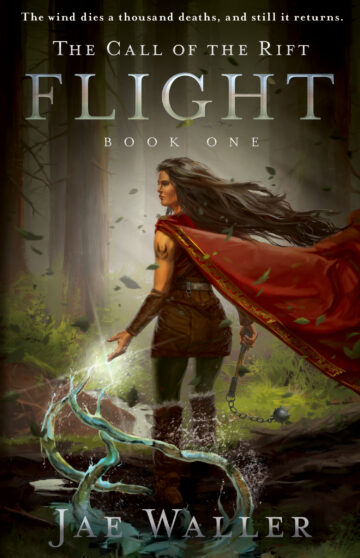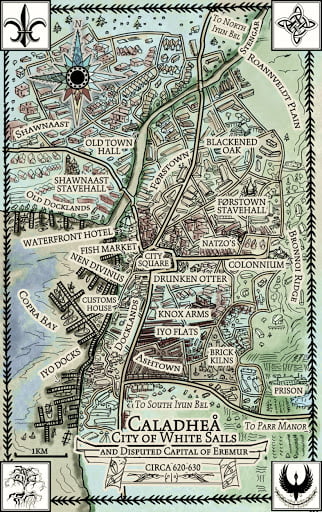#928 Jae Waller’s alt-historical fantasy
The Call of the Rift Book 1: Flight
by Jae Waller
Toronto: ECW Press, 2018
$19.95 / 9781770413542
*
The Call of the Rift Book 2: Veil
by Jae Waller
Toronto: ECW Press, 2020
$19.95 / 9781770415782
Both books reviewed by Natalie Lang


Jae Waller’s The Call of the Rift series sees a handful of strong-willed characters in a world filled with magic and myth who learn to accept who they are amid the possible destruction of their way of life. Readers, young and old, are pulled into this young adult alt-historical fantasy world where the setting, characters, atmosphere, and storyline grab hold of one’s mind and heart and refuse to let go.

Set in a mythical early colonial period of what is now British Columbia, three vastly different cultures collide: the Aikoto Confederacy, based on Indigenous peoples of the west coast; Sverbians, based on Vikings; and Ferish People, based on Spanish Conquistadors. Sparking an imaginative world from real practices, people, and technologies, and using threads from some lesser-known Canadian history, Waller avoids cultural appropriation by creating distinctive practices and spirituality for her imagined communities.
Waller’s invented names for characters and territory can at first be a mouthful, but as the books draw you in, any difficulty in following names and places becomes an afterthought. Indeed, her creations start to feel so authentic that I dearly missed the story’s mythical and magical qualities when I returned to the real world beyond her creative imagination. Waller includes a glossary of important vocabulary at the end of both books, as well as high-quality maps showing the place-names and topography of her fictional west coast, a welcome aid in situating oneself in the fantasy world that, as you read, really feels like a reimagined lush coastal British Columbia.


Waller’s background on the north Pacific coast, where she studied Indigenous art under a Haida/Nisga’ woodcarver and a Mohawk multimedia artist, shines in her descriptions. With beautiful language, powerful imagery, and west coast weather as common points of access, it is easy to fall into the storyline of Kateiko Rin, a defiant, independent, quick-witted, and curious young woman who – at the start of Book 1, Flight — leaves her home community of Anwen Bel in search of anywhere that doesn’t “feel like a slow isolated death” (p. 44).
“Too old to be with the children, [and] too young to have [her] own” (p. 12), Kateiko is feeling stuck in the Rin Jouyen (“people of the Lake Shore”). She won’t accept that her future is set for her, and instead craves freedom and adventure over an ancient and dusty way of life with no connection to the outside world.
After experiencing a vision during a dance ceremony, Kateiko and her friend Nili, against the counsel of their friend Fendul, who is an Okoreni — successors to the political, spiritual, and military leader of the jouyen — set off into a land known only by history and unknown to recent memory. They leave the Rin Jouyen seeking a new life farther south in an area that once housed her ancestors, hoping to create an identity of their choosing.
The journey Kateiko sets out on would be more than she bargained for. From the outset there is murder, love, abandonment, heartache, and danger of power and control. Kateiko, as a water caller (antayul) who can draw water from the earth and attune (shapeshift) into a grey wolf, falls into unrequited love with a fire caller (jinrayul). She comes to understand that Suriel, an air spirit and one of many who govern the weather and balance of nature, has gone rogue and is attempting to crack open a rift between two worlds. Kateiko has to choose between leaving the man she loves and saving colonists from Suriel’s wrath, colonists who settled areas of the Coastal Rainforest that had once been home to all of the Rin Jouyen. She will also have to “choose between who [she is] and who [she wants] to be known as. Both have consequences” (p. 74).
Flight moves along at a quick pace as Kateiko learns the truth about her ancestors, recent wars, and why the tribes remain divided and silenced from each other. With her strong voice and will, Kateiko helps to mend misunderstandings between cultures, communities, and families, and to encourage her followers to soften time-hardened emotions and learn to respect differences while retaining their own customs and beliefs. Others, however, have become more hostile and fearful of losing their way of life.
In a blend of myth, history, love, and drama, Kateiko comes to understand two truths: “Rivers keep flowing” and “The wind dies a thousand deaths, and still returns.” A great battle at the end of Flight lays destruction at the feet of all those who participate, and the battle against Suriel and those who mean to cause harm is far from over.

*

Book 2, Veil, sees the Rin Jouyen on the extinction list. Waller drops Kateiko Rin right into the thick of a voyage by ship to the Northern Territories and a snow-covered Innisban where mythical beasts lurk in deep waters, and where druid and runic magic could be their undoing.
Deceit, secrets, love, and the danger of losing oneself are prominent through this second instalment of The Call of the Rift series. Ancient alliances are renewed, sacrifices are made for the greater good, and protecting loved ones becomes paramount in a world where it is increasingly difficult to know who your allies are.
Suriel, the air spirit, has gone quiet at the start of Veil. Those from differing groups look to one another for help at a time of harsh winters, famine, and uncertainty in the wake of disaster. Kateiko understands that it is up to her to stop the next crisis. Faced with impossible choices, she is in on the brink of losing who she is to protect those she loves.
In Veil, Jae Waller has once again created a rich, deep, magical, and moody atmosphere where whispers of British Columbia’s deep human history seep through. While magic, giant beasts, and emotionally chaotic spirits rage through the story, BC’s west coast history is echoed in the descriptions of lush rainforest, the impact of colonization, the imposition of laws over those who had resided and traded for millennia and whose culture was misunderstood by the colonizers.
This twist on historic fiction, inspired by conflict between Indigenous people and European colonists during the Age of Sail in the Great Bear Rainforest and Coast Mountains, has resulted in an imaginative, fast-paced, adventurous, and sometimes heart-wrenching read. Veil is a wonderful book to pick up – and then it is wonderful to allow oneself to fall into another world completely. It is also timely and topical, as – behind its fictional veneer — it calls readers’ attention to the modern impact of Canadian colonization on the Indigenous inhabitants of the coast.
Jae Waller’s Rift and Veil, the start of a planned series of five books, offer an exceptional avenue for young adult and mature readers alike to engage in adventures filled with fear, drama, love – as well as prejudice and racism — and to explore what happens when a culture is threatened with extinction.
There is much to commend in these two books. I can’t wait for the next three instalments of the quintet and for Waller to take her readers on even greater adventures. I, for one, will follow her dynamic characters through an awe-inspiring world of magic, myth, drama, history, and fantasy.
*

Natalie Lang is a teacher and writer. She is also currently a master’s student in the GLS (Graduate of Liberal Studies) program at SFU. She is based in Abbotsford, BC, where she teaches literature at Rick Hansen Secondary, and lives in a renovated barn in the heart of Sumas Mountain. Editor’s note: For The Ormsby Review, Natalie has reviewed books by carla bergman (compiler and editor), Sonnet L’Abbé, Larry Hannant, Tanya dePape, Emily Lycopolus, Alicia Tobin, and Cait Flanders.
*
The Ormsby Review. More Books. More Reviews. More Often.

Publisher and Editor: Richard Mackie
The Ormsby Review is a journal service for in-depth coverage of B.C. books and authors. The Advisory Board consists of Jean Barman, Robin Fisher, Cole Harris, Wade Davis, Hugh Johnston, Patricia Roy, David Stouck, and Graeme Wynn. Scholarly Patron: SFU Graduate Liberal Studies. Honorary Patron: Yosef Wosk. Provincial Government Patron since September 2018: Creative BC
“Only connect.” – E.M. Forster


3 comments on “#928 Jae Waller’s alt-historical fantasy”
Thanks, Doug! These books are so wonderful. They were a pleasure to read.
Great review and lovely images. As her dad I am very proud of Jae’s accomplishments. I am also proud of you choosing a photograph I captured of Jae in a graffitied owntown Melbourne alley in October 2016. We look forward to the next 3 books.
Thanks, Doug. It was our pleasure!